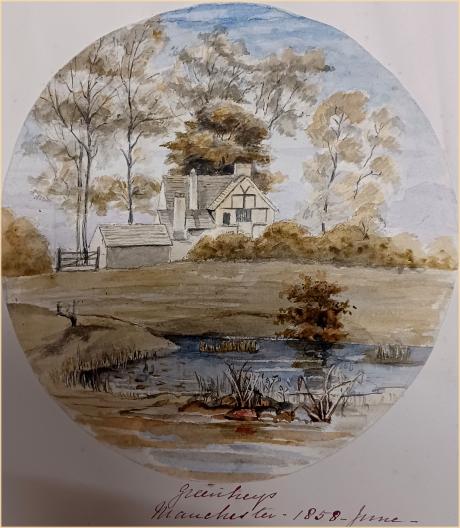signed inscribed and dated
Greenheys is an inner-city area of south Manchester, England, lying between Hulme to the north and west, Chorlton-on-Medlock to the east and Moss Side to the south. Elizabeth Gaskell's first novel, Mary Barton, published in 1848, opens with a description of Greenheys, then still a rural area on the outskirts of the city. The writer Thomas De Quincey and pioneer socialist Robert Owen both lived at Greenheys House, overlooking the now culverted Cornbrook river. Manchester Science Park is here, on Pencroft Way, Lloyd Street North.
Chapter 1
“There are some fields near Manchester, well known to the inhabitants as ‘Green Heys Fields,’ through which runs a public footpath to a little village about two miles distant. In spite of these fields being flat, and low, nay, in spite of the want of wood (the great and usual recommendation of level tracts of land), there is a charm about them which strikes even the inhabitant of a mountainous district, who sees and feels the effect of contrast in these commonplace but thoroughly rural fields, with the busy, bustling manufacturing town he left but half-an-hour ago. Here and there an old black and white farm-house, with its rambling out-buildings, speaks of other times and other occupations than those which now absorb the population of the neighbourhood. Here in their seasons may be seen the country business of haymaking, ploughing, &c., which are such pleasant mysteries for townspeople to watch: and here the artisan, deafened with noise of tongues and engines, may come to listen awhile to the delicious sounds of rural life: the lowing of cattle, the milkmaid’s call, the clatter and cackle of poultry in the old farmyards. You cannot wonder, then, that these fields are popular places of resort at every holiday time; and you would not wonder, if you could see, or I properly describe, the charm of one particular stile, that it should be, on such occasions, a crowded halting-place.”
Greenheys was approximately 1.5 miles from the centre of Manchester and until the 1830s it was largely open, rural countryside on the edges of the town. The name of the area was supposedly coined by Mary De Quincey, the mother of author Thomas De Quincey. The family had a house built there in 1791, when there were very few other buildings. Mary De Quincey named the house ‘Greenhay’ and the name stuck as urbanisation encroached on the area. Greenhay Hall itself was demolished in 1852.

